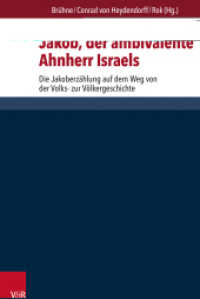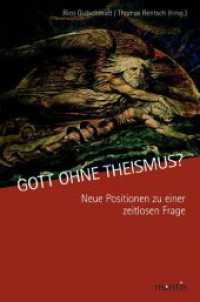基本説明
Provides a state-of-the-art overview of current work in defining, documenting, and developing the world's smaller languages and language varieties.
Full Description
In the last three decades, the field of endangered and minority languages has evolved rapidly, moving from the initial dire warnings of linguists to a swift increase in the number of organizations, funding programs, and community-based efforts dedicated to documentation, maintenance, and revitalization. "Sustaining Linguistic Diversity" brings together cutting-edge theoretical and empirical work from leading researchers and practitioners in the field. Together, these contributions provide a state-of-the-art overview of current work in defining, documenting, and developing the world's smaller languages and language varieties.The book begins by grappling with how we define endangerment - how languages and language varieties are best classified, what the implications of such classifications are, and who should have the final say in making them. The contributors then turn to the documentation and description of endangered languages and focus on best practices, methods and goals in documentation, and on current field reports from around the globe.
The latter part of the book analyzes current practices in developing endangered languages and dialects and particular language revitalization efforts and outcomes in specific locations. Concluding with critical calls from leading researchers in the field to consider the human lives at stake, "Sustaining Linguistic Diversity" reminds scholars, researchers, practitioners, and educators that linguistic diversity can only be sustained in a world where diversity in all its forms is valued.
Contents
Introduction Kendall A. King, Natalie Schilling-Estes, Lyn Fogle, Jia Jackie Lou, and Barbara Soukup PART I: DEFINING 1. Linguistic Diversity, Sustainability, and the Future of the PastSuzanne Romaine 2. When is an "Extinct Language" Not Extinct? Miami, a Formerly Sleeping LanguageWesley Y. Leonard 3. Evaluating Endangerment: Proposed Metadata and ImplementationM. Paul Lewis PART II: DOCUMENTING4. Endangered Language Varieties: Vernacular Speech and Linguistic Standardization in Brazilian PortugueseGregory R. Guy and Ana M.S. Zilles5. The Linguistic Negotiation of Complex Racialized Identities by Black Appalachian SpeakersChristine Mallinson 6. Working at "9 to 5" Gaelic: Speakers, Context, and Ideologies of an Emerging Minority Language RegisterEmily McEwan-Fujita7. Voice and Biliteracy in Indigenous Language Revitalization: Contentious Educational Practices in Quechua, Guarani, and Maori ContextsNancy H. Hornberger PART III: DEVELOPING 8. Endangering Language Vitality through Institutional Development: Ideology, Authority, and Official Standard Irish in the GaeltachtTadhg O hIfearnain 9. Scandinavian Minority Language Policies in Transition: The Impact of the European Charter for Regional or Minority Languages in Norway and SwedenLeena Huss 10. Language Development in Eritrea: The Case of BlinPaul D. Fallon 11. Indigenous Language Policies in Social Practice: The Case of NavajoTeresa L. McCarty, Mary Eunice Romero-Little, and Ofelia Zepeda 12. Heritage Language Education in the United States: A Need to Reconceptualize and RestructureJoy Kreeft Peyton, Maria Carreira, Shuhan Wang, and Terrence G. Wiley 13. Language Diversity and the Public InterestWalt Wolfram AFTERWORD 14. At What Cost? Methods of Language Revival and Protection: Examples from HebrewElana Shohamy 15. Unendangered Dialects, Endangered PeopleWilliam Labov Index







